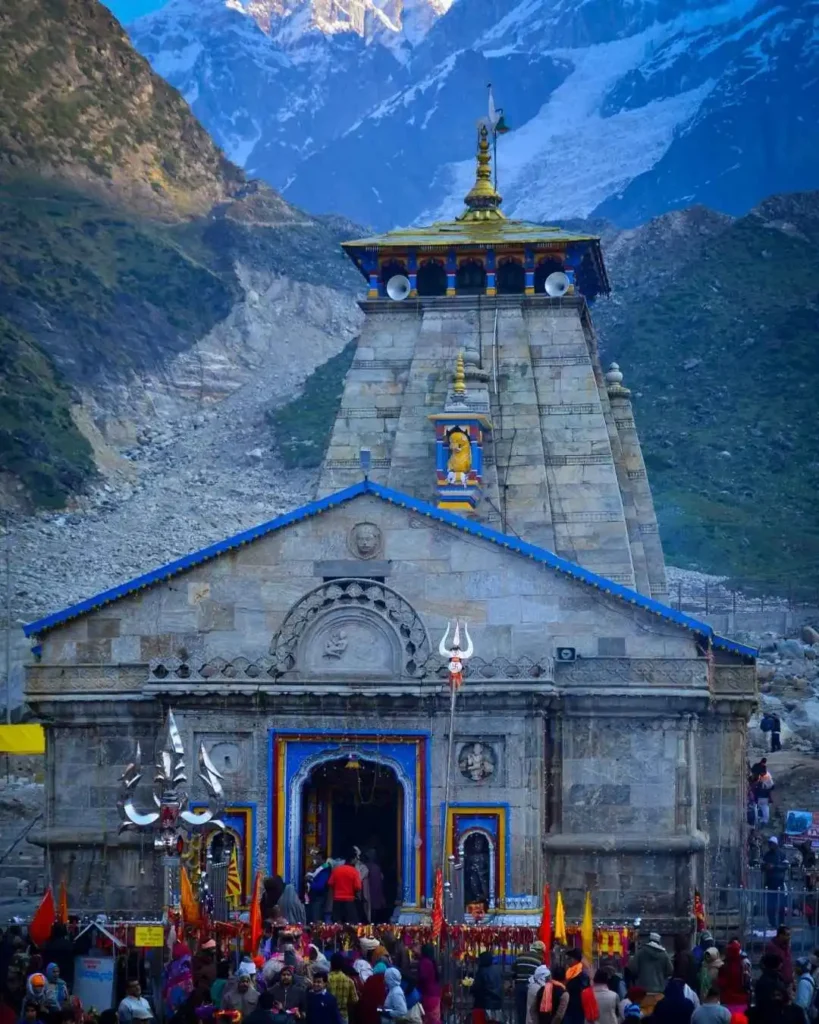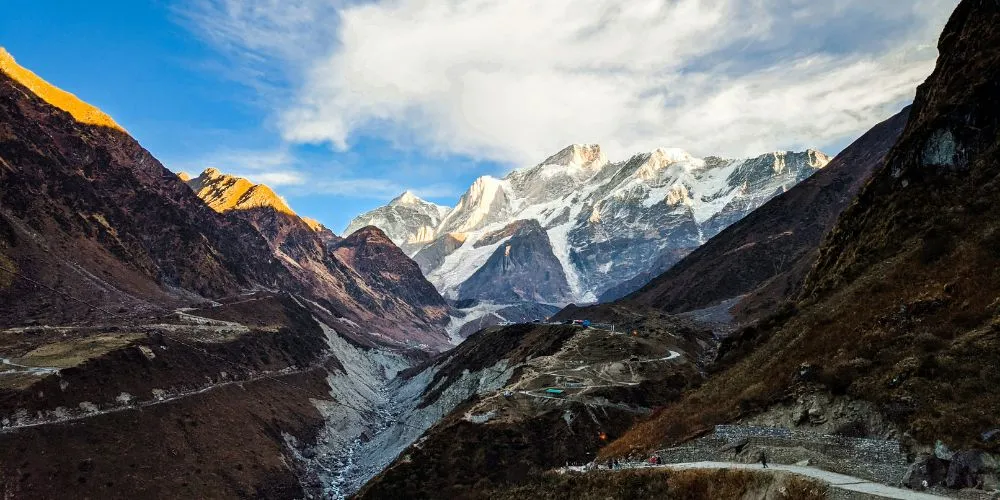Kedarnath is not just a place; it’s a feeling in your heart and soul. For thousands of years, people have trekked up hills, braved weather, and crossed rivers just to stand before Kedarnath Temple, one of the holiest shrines for Lord Shiva devotees. If you’re planning a Kedarnath Yatra, keep reading: this guide covers travel, registration, Rishikesh to Kedarnath distance, places to stay, and everything you need to know to make your journey easier, safer, and full of memories.
Why Is Kedarnath So Special?
Kedarnath sits high in the Garhwal Himalayas, surrounded by peaks, glaciers, and rivers. It’s not just any temple; it’s one of twelve Jyotirlingas (special places where there is immense spiritual energy because Shiva himself is believed to be present). The temple is a symbol of endurance and hope, often snow-bound, but always welcoming.
The lingam here isn’t carved by hand; it emerged from the earth, as per legend, when Shiva vanished. Legends say that after the Mahabharata war, the Pandavas wanted forgiveness for their actions. Lord Shiva, wanting to avoid them, turned into a bull and hid in Kedarnath, leaving behind his hump as the stone lingam you’ll see inside the temple. Pandavas were forgiven for their sins only after much penance.
Many devotees also do ‘Char Dham’; the four sacred Uttarakhand shrines, where Kedarnath is seen as the closest to the divine.

Kedarnath Temple
Rishikesh to Kedarnath Distance & Travel Routes
Rishikesh to Kedarnath distance is around 216 kilometers. This might sound short, but the journey takes 9-10 hours by road, plus the trek! The route winds from Rishikesh to Devprayag, Srinagar, Rudraprayag, Agastyamuni, Guptkashi, Phata, Sonprayag, and finally Gaurikund.
- From Rishikesh, get a taxi, state-run bus, or shared cab to Sonprayag.
- From Sonprayag, take a local shared jeep up to Gaurikund.
- From Gaurikund, the real challenge begins, an 18km trek to Kedarnath Temple. You can walk, hire a pony, or book a ‘palki’ (palanquin). The route is scenic, but can be tough in weather or for new trekkers.
- If trekking isn’t possible, helicopter rides operate (from Phata, Guptkashi, Sirsi) and are convenient for seniors or those short on time.
Pro tip: The road is winding and mountainous. Eat light, keep medicines handy, and avoid night travel.
Kedarnath Yatra Registration and How To Do It
Yatra registration is now compulsory, mainly to help keep pilgrims safe and organised. You can register online or at physical centres in Rishikesh, Haridwar, and other starting points.
Quick steps for online registration:
- Go to the Uttarakhand Tourism Care site: https://registrationandtouristcare.uk.gov.in/
- Click on ‘Register’; enter name, number, ID, and family/group details.
- Enter OTP sent to your mobile, set a password.
- Add journey date, details, emergency contact, and upload your ID and photo.
- Confirm and save your registration; carry a printout or screenshot for security checks.
Don’t skip this step! Without registration, you may not be allowed to trek or enter the sanctum.

Best Time to Visit
If you’re new to high-altitude travel, the right season can make all the difference.
- May-June (Summer): Most popular. Pleasant weather (10–15°C), clear skies, snow starting to melt, and the temple opens for darshan.
- September-October (Autumn): Fewer crowds, chilly nights (5–12°C), amazing mountain views, lush greenery after the monsoon.
- July-September (Monsoon): Not recommended. Heavy rain, slippery paths, risk of landslides, flash floods, and road closures.
- November-April (Winter): Temple closes, area gets heavy snow (-10°C to -20°C), trekking nearly impossible.
Travel tip: Check weather forecasts, and always ask locals about conditions before finalising dates.
Staying in Kedarnath
Not luxurious but you’ll find enough comfort for rest and warmth; thanks to local communities, dharamshalas, and budget hotels.
- Dharamshalas/Ashrams: Punjab Sindh Awas, Bikaner House, Jai Jalaram Ashram, and Behl Ashram offer private rooms, attached bathrooms, hot water and basic vegetarian food, all within walking distance of the temple.
- Guesthouses: Clean, safe, and friendly, good for single travellers, couples, and small groups, with costs from ₹1500–₹2500 per night.
- Booking: In the busy season, book at least a month ahead, especially for large groups or families.
- Food: Vegetarian and simple; dal, rice, vegetables. Carry snacks and bottled water.
What to Expect at Kedarnath Temple
As you reach Kedarnath, the first look at the ancient stone temple, with mighty peaks all around, is unforgettable. The temple opens from May till late October, with daily aartis, Sanskrit chants, and thousands of pilgrims from all over India.
Darshan tips:
- Queue for entry (expect 3–5 hours for darshan during peak days).
- Early morning (before 7 AM) is best for a peaceful experience, though many prefer evening aarti.
- Dress warmly; temple interiors are cold. Cotton kurtas, shawls, thermals, woollen socks and shoes for walking are a must.
Explore around; Bhairavnath Temple, Vasuki Tal trek (for fit trekkers), and Triyuginarayan Temple (famous wedding spot of Shiva-Parvati).
Preparing for Yatra
For first-timers:
- Pack light but warm, thermals, raincoat, woollen cap, gloves, and sturdy shoes.
- Sunscreen, moisturisers, and sunglasses; you may not think you’ll need them, but the sun’s strong.
- First-aid kit, pain balm, altitude sickness tablets.Water bottles, dry fruits, energy bars for the trek.
- ID proof, registration printout, emergency contact details.
Health tips: Acclimatise at Sonprayag or Gaurikund. Drink lots of water, move slowly, avoid alcohol, and listen to your body.
Places to See Nearby
Kedarnath isn’t just about the temple; explore Guptkashi (mini Kedarnath, with Ardhanarishwar Mandir), Triyuginarayan Temple, Vasuki Tal (5km trek for lake lovers), and Devprayags (river confluences).
Rishikesh and Haridwar before/after the trip are perfect for Ganga aarti, yoga, or relaxing by the river.
In Conclusion
Kedarnath calls people from all walks; young, old, fit, or nervous. It’s okay to be slow, to stop, to sit and stare at the valley. At the end, you’ll remember only the simple joys, the sunrise, the temple bells, the shared chai with strangers, and the feeling of standing close to something eternal.
So complete your Kedarnath Yatra registration, pack your bags, and answer the mountain’s call. Divinity, healing, and a lifetime of memories await at Kedarnath.
By: Anushka Singhal
